Introduction
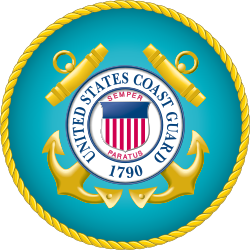 The Coast Guard is now a widely accepted concept in most navies, when it exists, alongside, complementary, but not substitute to a regular Navy. Its role was defined early on to take charge on local policing missions inside a large range of duties, which non intercepted the battle fleet role of the US Navy. In its case, the US Coast Guard, a model for all the others around the world (abbreviated USCG) was as old as the USN itself, as its earliest ancestor went all the way back to the 1790 Revenue Marine. However, it was created officially on January 1915 in its “modern” form, to discharge the Navy for mundane tasks, and placed since under the authority of the treasury, not the armed forces. However, its missions somewhat intersected the Navy’s still several times in US history, and it famously took part in wartime operations in WW2, from coastal patrol to providing personnel to the USN (like landing craft drivers).
The Coast Guard is now a widely accepted concept in most navies, when it exists, alongside, complementary, but not substitute to a regular Navy. Its role was defined early on to take charge on local policing missions inside a large range of duties, which non intercepted the battle fleet role of the US Navy. In its case, the US Coast Guard, a model for all the others around the world (abbreviated USCG) was as old as the USN itself, as its earliest ancestor went all the way back to the 1790 Revenue Marine. However, it was created officially on January 1915 in its “modern” form, to discharge the Navy for mundane tasks, and placed since under the authority of the treasury, not the armed forces. However, its missions somewhat intersected the Navy’s still several times in US history, and it famously took part in wartime operations in WW2, from coastal patrol to providing personnel to the USN (like landing craft drivers).
Here is a comprehensive review of all the history, missions, organization and ships classes, from 1915 to this day. First part: Origin and development, assets in WW1 and until WW2. Next updates: The USCG in WW2 (2026), and in the cold war (2027).
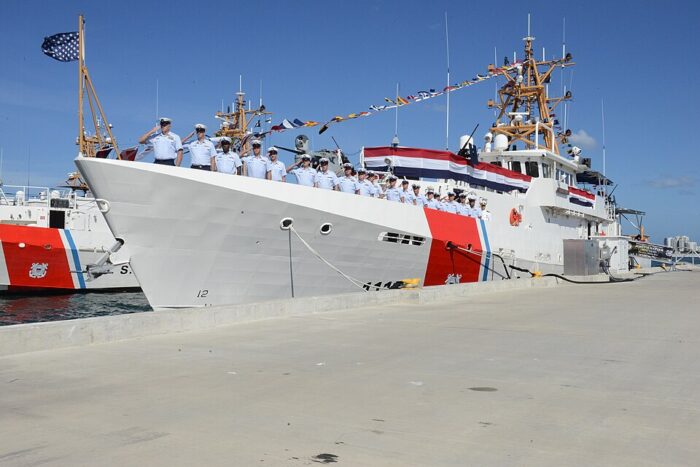
History
The United States Coast Guard (USCG) is today the primary maritime security, search and rescue, law enforcement service branch of the US armed forces. One of eight. It is unique today for its maritime law enforcement mission has jurisdiction in both domestic and international waters, with a federal regulatory agency mission. Today the world’s largest coast guard and a model for all international coast guard services, it is however now in the presence of a growing competitor, the Chinese Coast Guard. It’s assets, from moderate to large “cutters” are all armed and capable, albeit lacking advanced sensors and missiles unlike Navy ships.
The U.S. Coast Guard main mission, more relevant after 1945 as the US assumed its global role, projecting the USN on all seas, to protects the US borders and economic (EEZ) and security interests abroad, defends sovereignty by safeguarding sea lines of communication and commerce in territorial waters plus its extensive EEZ, world’s largest. Transnational threats added recently the cyberspace as a new mission. Its global presence counts on permanently-assigned personnel, and its multi-mission “white hull” fleet could also leverage diplomatic soft power and humanitarian and security assistance. In the humanitarian chapter, the USCG saved thousands if not tens of thousands of lived any year in U.S. waters alone, while providing emergency response and disaster management throughout the world.
Its operation remains under the U.S. Department of Homeland Security in peacetime, but like in WW1 it can be transferred in whole or part to the U.S. Department of the Navy by act of Congress (which happened in April 1917 to face the U-Boat threat). The USCG operated under the treasury and from 1969 to the Department of Transportation. In World War II, from December 1941, it was transferred to the Navy by President Franklin Roosevelt order, not the Congress.
Early Origins: The US Revenue Cutter Service
The Revenue Marine (1790)
This service was created by Secretary of the Treasury Alexander Hamilton, which lobbied Congress for a “system of cutters” to enforce tariffs over trade incoming to the young US nation. On 4 August 1790 Congress passed the “Tariff Act” and funded the construction of ten cutters, recruitment of 40 revenue officers. Each cutter was manned by a master, three mates, all commissioned officers, four mariners and two boys. The colletive name for this was “Revenue-Marine” but each revenue cutter operated independently, assigned to patrol a section of the east coast, reporting to the Customs House in a major port for the corresponding state.
More so, when the young Continental Navy, ancestor of the USN, was disbanded, up to to 1798, when the USN was created to face another threat on trade overseas the “barbary pirates”, these “revenue cutters” became the only US naval force and they took a large variety of assignments, being armed to fight piracy, rescuing mariners or ferrying government officials, and even carrying mail along the eastern seaboard. In 1794, the Revenue-Marine started to be used to prevent the trade of slaves to the United States. From 1794 and 1865 they captured some 500 slave ships and in 1808, the Revenue-Marine enforced President Thomas Jefferson’s embargo to European trade. The 1822 Timber Act asked them to protect government timber from poachers and they were also were put at the disposal of the Navy in the Quasi-War with France (1798-1799), War of 1812, the West Indies Anti-Piracy Operation or the Mexican–American War.
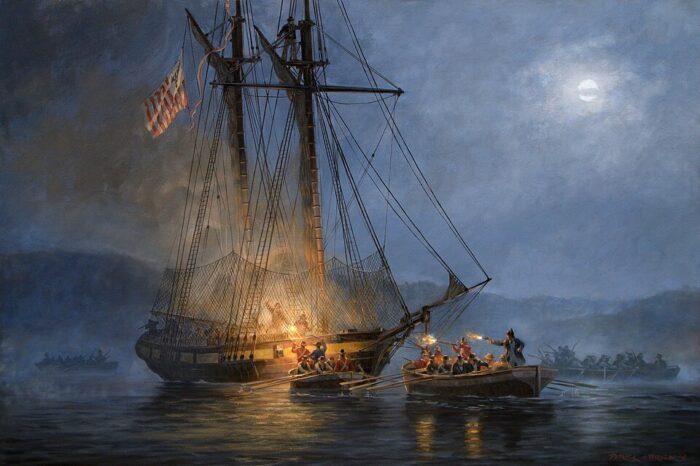
War of 1812: The gallant defence of the Cutter Surveyor
The US Revenue Cutter Service (1863)
Civil War:
The service seen above was renamed “Revenue Cutter Service” by a Congress act of 1863. But it was still widely called the “Revenue-Marine” until 1890. The American Civil War saw USRC Harriet Lane firing the first naval shots of the war on the rebel steamer Nashville at the siege of Fort Sumter. By Pdt. Lincoln “Act of March 2, 1799” all revenue cutter engaged in combat duty with and under command of the Navy. Notably the North Atlantic Blockading Squadron. Officers who left the Service to join the Confederacy retained their commissions by late 1861 so the Confederate Congress authorized them to act on military capacity as well, some joining the army and navy, others manning Confederate cutters.

The Cutter Harrier Lane
Alaskan Conquest (1867-1900s):
After the war, the purchase of Alaska from Russia saw the recently named USRC Lincoln under 1st Lieutenant George W. Moore sail to Sitka to provlaim US sovereignty while attached to the Customs in San Francisco. This was a shore reconnaissance. At the peak of the wonquest of the West in the 1880s-1890s, the Revenue Cutter Service took a great important for the conquest of Alaska, bringing any resources necessary to built the first outposts of the “northern frontier”. Captain “Hell Roaring” Michael A. Healy (USRC Bear) brought notably the reindeer to Alaska to connstitute a food source for native Eskimos and US colonists. The winter of 1897–1898 saw 1st Lieutenant David H. Jarvis drive a reindeer herd across 1,500 miles in an overland Relief Expedition for starving whalers trapped by ice near Point Barrow, earning olater the first Congressional Gold Medals for “heroic service rendered” in June 1902.
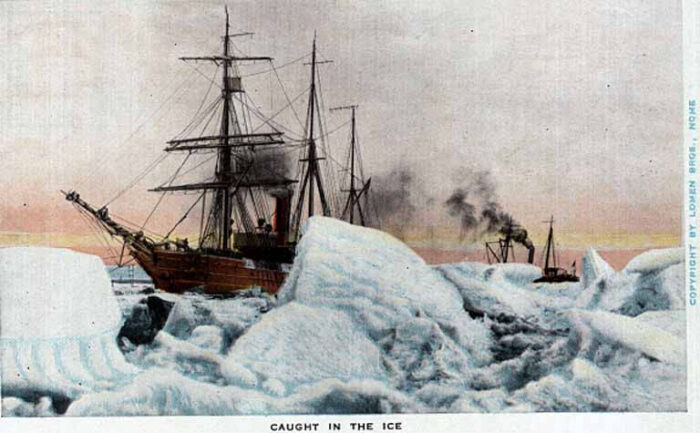
USRC Bear to the rescue of SS Corwing caught by ice near Nome, Alaska, 1900s
1898 Spanish–American War saw yet another mobilization of the USCS, with USRC Hudson assisting the U.S. Navy at the Second Battle of Cárdenas, towing the disabled USS Winslow out of range from the Spanish coastal artillery with three sailors received the Navy Medal of Honor with a special medal created for the service.
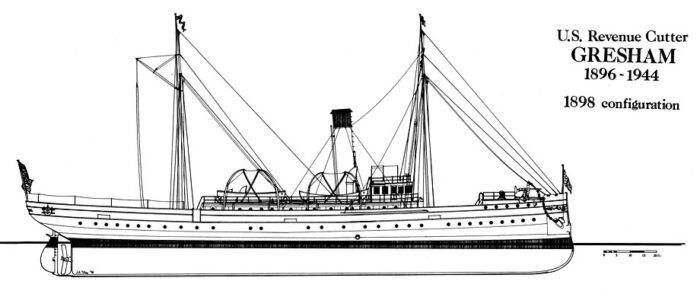
United States Lifesaving Service (1875)
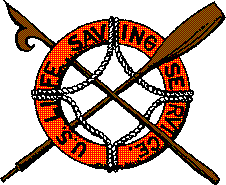 This service was not unified at fiurst. Each coastal city had its own voluntary organization in the 1700s, until the 1800s to help shipwrecked mariners using small boats from shore-based stations. The most important was the Massachusetts Humane Society (est. 1786). These were storehouses for boats and equipment, volunteers would keave their jobs at a moment notice when signalled such an event and join the station to man the boats. The Newell Act on 14 August 1848 saw the Congress appropriating $10,000 to fund lifesaving stations, loosely administered by the Revenue-Marine, until 1 February 1871, when Sumner Kimball was appointed Chief of the Revenue Marine Division of the Treasury Department by Secretary of the Treasury George S. Boutwell.
This service was not unified at fiurst. Each coastal city had its own voluntary organization in the 1700s, until the 1800s to help shipwrecked mariners using small boats from shore-based stations. The most important was the Massachusetts Humane Society (est. 1786). These were storehouses for boats and equipment, volunteers would keave their jobs at a moment notice when signalled such an event and join the station to man the boats. The Newell Act on 14 August 1848 saw the Congress appropriating $10,000 to fund lifesaving stations, loosely administered by the Revenue-Marine, until 1 February 1871, when Sumner Kimball was appointed Chief of the Revenue Marine Division of the Treasury Department by Secretary of the Treasury George S. Boutwell.
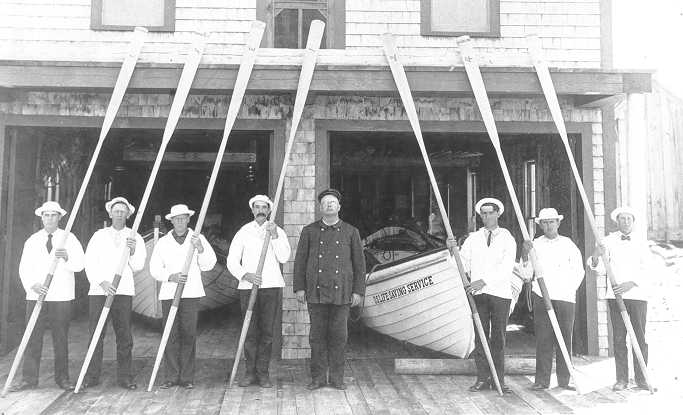
Vermillion lifesaving station keeper and crew, 1890s
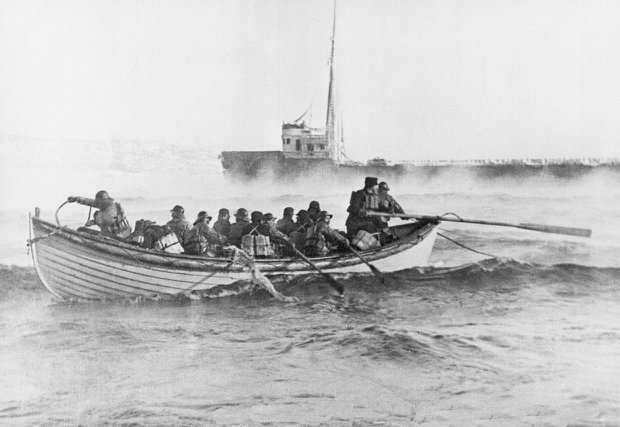
3 March 1875: The Congress formalized the organization of the lifesaving division with $200,000 being appropriated to build new stations, maintain the others, and pay for full-time crews for the first time, no longer volunteers, although they still existed alongside.
1878: The U.S. Lifesaving Service is officially organized, Kimball at its head as superintendent until the merger with the Revenue Cutter Service in 1915.
The Lifesaving Service’s legacy since then permeated the revenue cutter service as in the modern USCG, search and rescue are still key in the eyes of the public. They now own the motto, “You have to go out, but you don’t have to come back” from 1899 regulations and many traditions survived from the Lifesaving Service like the specialists inside the USMC are called “surfmen” with the Surfman Badge being awarded to coxswains qualifying to operate motor lifeboats in heavy surf conditions.
United States Coast Guard Academy (1876)
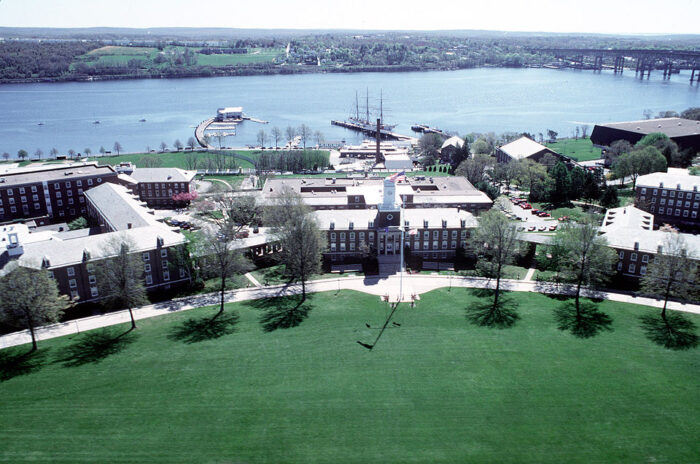
The School of Instruction was established for the Revenue Cutter Service on 31 July near New Bedford, Massachusetts, from USRC James C. Dobbin and from 1878 USRC Salmon P. Chase, designed for and modified for training. It was later moved to Curtis Bay (Maryland) in 1900, then Fort Trumbull (New London, Conn.). The cursus represented 2-year class work plus tutoring in technical subjects. In 1903, a 3rd year instruction was added and line officers and engineers could be hired from civilian life.
In 1906 a cadet engineering program was created as the new cutters were all steam powered. This still was a select club of 5-10 cadets per class. In 1914 it was renamed the “Revenue Cutter Academy” and after the merger in 1915, the “United States Coast Guard Academy”. In February 1929, the Congress appropriated $1,750,000 for a new dedicated complex located on new lands purchased by New London purchased on the Thames River, then donated. Construction started in 1931, the first cadets arrived in 1932 and a 4th year was added in 1932.
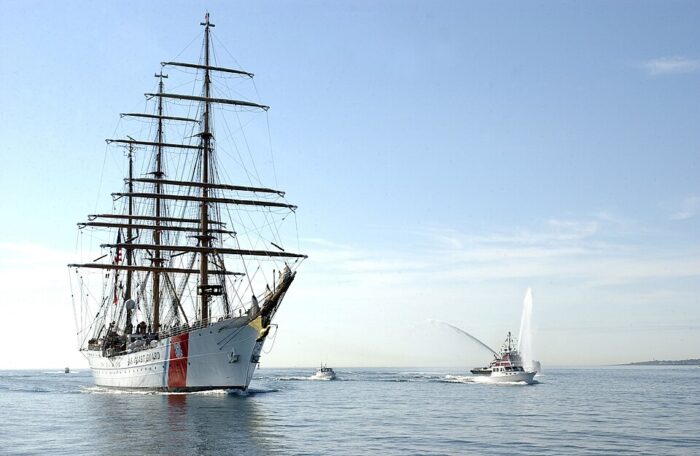
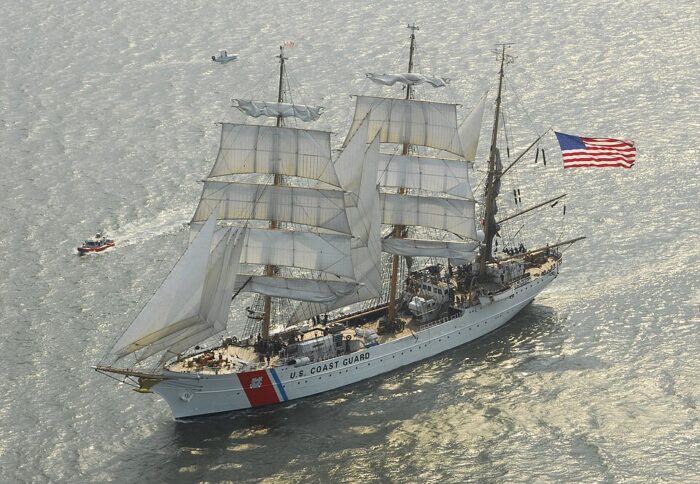
1915 Merger with the U.S. Life-Saving Service
On 28 January 1915, the United States Revenue Cutter Service and United States Lifesaving Service were merged by act of Congress. To create the US Coast Guard. It started with a staff of 255 officers, 3900 warrant officers and ratings. There were 17 regional commands with four depots and an academy. The fleet consisted in 25 cruising cutters, 20 harbor cutters and 280 lifeboat stations. Gover the fact the continental US comprised two coasts over immense distances and that cutters needed maintenance, this was not a massive fleet for its mission.
The USCG in WW1
The Coast Guard was mobilized at the Declaration of War on 6 April 1917, but by late 1916 already, the Interdepartmental Board on Coast Communications recommended its adoption on all local stations for a higher state of readiness especially along the east coastline. Telephone needed to be installed on all lighthouses and lifesaving stations and all other government coastal facilities.
Some in the USCG were also keen on aviation, and 3rd Lieutenant Elmer Stone was sent to acquire a formation at the Naval Flight Training on 21 March 1916 already, nearly a year before the declration of war to Germany. On 22 March 1917, a twelve-page manual “Confidential Order No. 2, Mobilization of the U.S. Coast Guard When Required to Operate as a Part of the U.S. Navy.” which put the basis of operations. At the time indeed, Germany indeed announced a policy of unrestricted submarine warfare started already by 30 January 1917, and that included neutral shipping. U.S. merchant ships sunk even before January included SS Housatonic, Vigilancia, Healdton, Aztec, claiming 36 U.S. lives.
On 6 April 1917, the Coast Guard was transferred under USN operational control, with cutters reporting their perparedness state to the nearest Naval District commander. All normal operations were suspended apart rescues. Secretary of the Navy Josephus Daniels also precised the USCG HQ administrative details would not be changed. The Coast Guard consisted had at the time 4000 personnel on 23 cruising cutters, 21 harbor cutters, 272 rescue stations. There were only 21 cadets at the Coast Guard Academy. It was still reorganized after the merger and interaction them needed to be built still. Skils being different, surfmen could that wish to man cutters needed training and were degraded in rank so transfers were rare. USCG Chief petty officers were assigned to Navy ships were also paid less. Coast Guard cutters were however quickly put to good use by the Navy, fill gaps in the USN. Their personel were seen as experienced mariners and were placed on Navy ships to fill in for crew shortages, lack of experience as ships weree cranked up too quick to have trained crews. In January 1918, Myrtle Hazard, became the first woman in the USCG as telegraph operator, and Electrician 1st Class. Son also she was joined by her twin sisters Genevieve and Lucille Baker, albeit they were not accepted. Cutters were used for ASW escort at first.
By the late afternoon of 26 September 1918, USCGC Tampa escorted convoy HG-107, via the Irish Sea from Gibraltar. Off Milford Haven, Wales, she was underway 19:30 in the Bristol Channel when spotted by UB-91. The latter dove, took position, firing a torpedo from her stern tube at 20:15 from 550 meters leaving no chance to Tampa, not built to resist any torpedo: She exploded portside amidships and rapidly sank with all hands (111 Coast Guardsmen, 4 USN sailors, 11 RN sailors, 5 Maritime Service Merchant Marines. This became the largest single loss of Coast Guard personnel in WWI. However, despite their limited numbers, the 23 cutters were put to hard work trying to escort all convoys along the coast. Until November 1918, telephone was installed and its network of stations and advanced lighthouses especially, which had a better view than any other outposts by default of aviation, proved especially valuable, signalling surfaced U-Boats at many occasions. The direct lines went to local USN HQs, vectoring ASW means. The system was still used in WW2.
Indeed, the story of USCG aviation started postwar.
The USCG in the Interwar
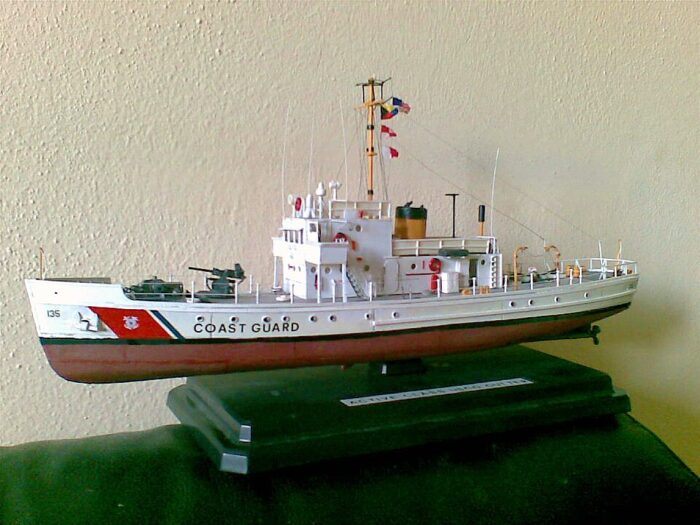
An active class Cutter model in WW2
In 1920 the House Committee on Interstate and Foreign Commerce had hearings about the recent merging creating the Coast Guard and integration into the USN. The same year, the CG was given several former U.S. Navy destroyers to help enforce Prohibition. This was not entirely successful, but that operational experience proved invaluable in World War II. The USN soon considered the service a “Hooligan Navy” due to the flexibility in enlisting discharged men from other services. It almost became a term of pride within the service. Commandant Billard also installed withing the service its first intelligence operation with experts in cryptology, counterintelligence and had its first signals intercept vessels built, also vital in WW2. The “rum runners” needed the reactivation of numerous destroyers in the interwar, all along the prohibition. Some served on the great lakes due to shipments to Chicago from Canada, others in the gulf of Mexico. They were fast, impressive to see, and sometimes received modifications for the task.
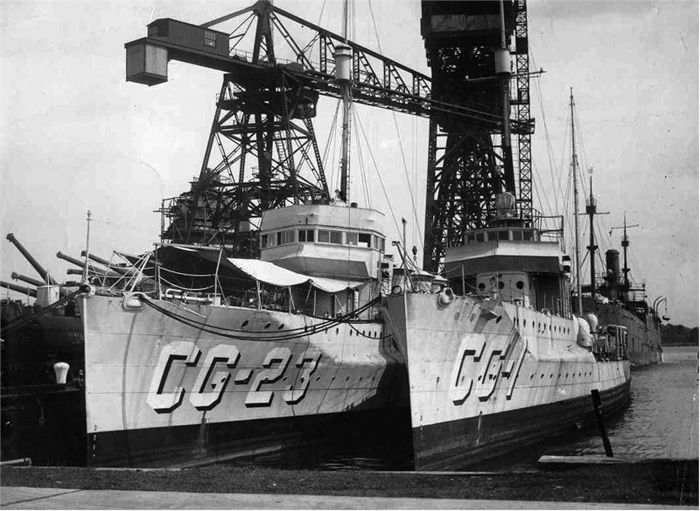
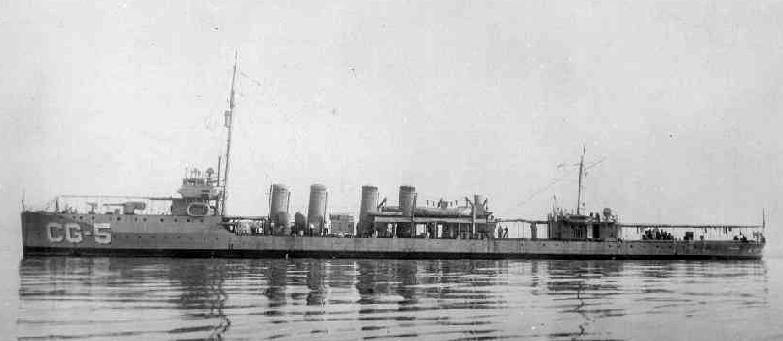
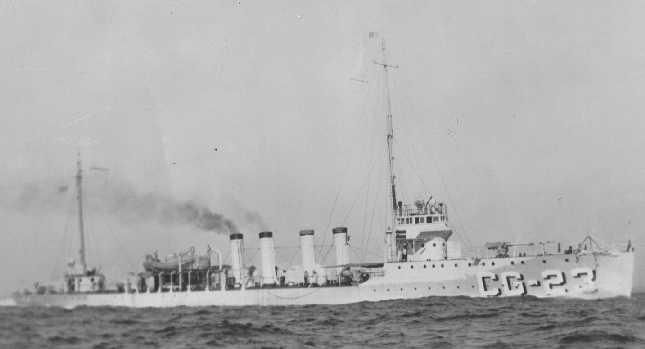
Tucker and Cassin (top), USS Ericsson (DD-56) as CG-2 (mid) and USS Tucker (DD-57) as CG-23, loaned for “rum patrols” in 1926-27. Dozens of destroyers of earlier classes, Paulding, Cassin, O’Brien, Tucker, Sampson, Caldwell were mobilized for such operations.

A profile of USS McCall, CG-14, “rum patrols” in 1929 as part of the Special patrol force in Charleston.
Largest Humanitarian Operation
The USCG had its largest humanitarian operation so far when addressing the disastrous 1927 Mississippi River flood, rescuing 43,853 people, saved 11,313 head of livestock and prvided urgent transportation for 72 mean and women in need of hospitalization. In all, 674 coast guardsmen, 128 Coast Guard vessels were mobilized in this operation.
Bureau of Marine Inspection and Navigation
In the 1930s the great depression forced austerity and reorganization measures which also later concerned the USCG: The Steamboat Inspection Service was merged with the Bureau of Navigation (1884) to oversee merchant seamen regulation on 30 June 1932. In 1934, this was put to good use when investigating the disaster of the liner Morro Castle, in flames with great loss of lives off the coast of New Jersey (124 passenger and crew), prompting new fire protection standards by the “Act of May 27, 1936”, seeing the former Bureau of Navigation and Steamboat Inspection Service to be merged as the “Bureau of Marine Inspection and Navigation”. It was temporarily transferred to the Coast Guard by executive order on 28 February 1942. Since the USCG was already tasked of port safety and security missions, this fit like a glove, and became permanent in 1946.
USCG Air Operations:
In 1920 Rear Admiral William R. Reynolds, Commandant, obtained six surplus Curtiss HS-2L flying boats on loan from the Navy’s Bureau of Aeronautics, establishing the Coast Guard’s first air station at Morehead City, North Carolina, starting operation on March 24, 1920. Since it was peacetime, their role was SAR.
Soon this young service would gain its laurels: Lt. Cdr. Carl von Paulsen sent his seaplane Arcturus in heavy seas by January 1933 off Cape Canaveral to rescue a boy adrift in a skiff. It managed to land, save the boy, but sustained so much damage that it could not take off and eventually thanks to von Paulsen’s navigation skills, washed onto the beach. He was awarded the Gold Lifesaving Medal for this rescue, the first for the air service.
Coast Guard Auxiliary:
On June 23, 1939, the United States Congress passed the Coast Guard Reserve Act of 1939. This created a volunteer reserve force for the USCG, a civilian volunteer force, predecessor of the Coast Guard Auxiliary with a split made in 1941.
The United States Lighthouse Service, oldest government agency (7 August 1789) was also absorbed by the Coast Guard on 1 July 1939.
Interwar USCG Cutters
The United States is unusual in having a second military sea force, the Coast Guard, which in peaceume is part of the civil government (in 1922—46 under the jurisdiction of the Treasury Department) but in war becomes part of the Navy; in fact the Coast Guard fell under naval jurisidiction on L November 1941, Peacetime tasks are the enforcement of maritime law (including laws against smuggling) and assistance to life and property on the sea; the latter includes the International Ice Patrol and the operation of harbours. Indeed, the Coast Guard was formed in 1915 by the amalgamation of the Revenue Cutter Service, tormed in 1790, and the Lifesaving Service; in 1939 the Lighthouse Service merged with the first two.
The Coast Guard fleet included a wide range of ‘cutters’, the largest of which were similar to Navy gunboats, as well as motor launches for harbour and coastal operations, and a fleet of buoy tenders. This fleet grew spectacularly during the 1920s in the face of an explosion of smuggling (rum-running’) brought on by Prohibition. In 1924 the Navy transferred twenty destroyers (numbered CG1-20 in Coast Guard service): 13 of the 750-ton type and 7 ‘thousand tonners’; five more ‘thousand tonners’ (CG21-25) were added in 1926, and six ‘flush-deckers’ became CG15-20 in 1930, replacing six of the earliest ships.
At the same time there was a massive patrol boat programme, which at its peak produced 203 74ft lin boats, numbered between CG100 and CG302; 51 of them were transferred to the Navy upon the expiration of Prohibition, and formed the core of the YP force. There were also thirteen 99ft 8in boats (210 tons), which were named; some of these, too, went into the Navy district patrol force during the 1930s. However, the Coast Guard retained its larger ‘cutters’, which performed valuable ASW service in wartime. The ‘Treasury’ class also served as amphibious command ships. Moreover, the new generation of Coast Guard motor launches, most notably the 83-footers, were employed in European waters.
In addition, the Coast Guard provided a large pool of trained personnel, who manned a total of 30 destroyer escorts, 75 frigates, 22 transports, 9 attack transports, 15 cargo ships, 5 attack cargo ships, 18 petrol tankers, 76 LSTs, 28 LCIs, and 33 smaller Navy craft, as well as 288 Army vessels. At the end of the war the Coast Guard took over many sub-chasers as it attempted to develop a long-range search and rescue branch to deal with aircraft lost at sea, and apparently for a time operated the weather ships converted in 1944-45
 Active class Cutters (1926)
Active class Cutters (1926)
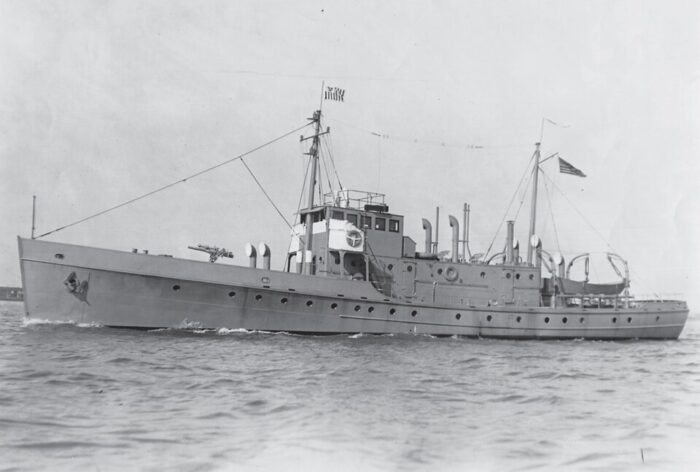
USCGC Jackson (WPC-142) as completed in 1927
ACTIVE (125ft) class Coast Guard cutters (launched 1926-27)
Class: Active, (extant 1980), Agassiz (decommissioned 13.10.69), (sold 28.10.1969), Antietam (lost 14.9.44), Bonham (sold 1959), Boutiell (sold 1964), Cahoone (discarded—1970s), Cartigan discarded 1970s), Colfax (exMontgomery sold 1956), Crawford (sold-#947), Diligence (sold 1964), Dix (sold 1948), Ewing (decommissioned 23.6.67), Faunce (sold 1964), Fredenck Lep (discarded 1970s), General Greene (decommissioned 15.11.68), Harriet Lane (sold 1949), Jackson (lost 14.9.44), Kimball (decommissioned 31.12.68), Legare (discarded 1970s), Marion (sold 1963), McLane (decommissioned 31.12.68), Morris (decommissioned 7.8.70), Nemaha (sold 1958), Pulaski (sold 1957), Reliance (sold June 1948), Rush (sold 1964), Tiger (sold 1948), Travis (sold 1963), Vigilant (sold 1956), Woodbury (sold 1963), Yeaton (decommissioned 18.7.69), Cuyahoga (deleted 1978), (WPC125-WPC157).
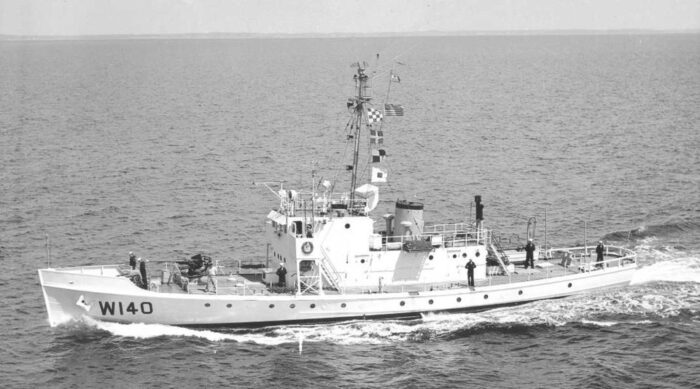
USCG General Greene in 1962
The construction of these craft was a consequence of Prohibition: although the smal! motor launches were able to compete with rum-running craft in close coastal waters, it soon became apparent that it would be necessary to trail the foreign cargo carriers supplying the coastal craft, to prevent cargo transfer. The design emphasised seaworthiness and cruising radius, and they were powered by twin diesels of the highest power available, with mechanical clutches and reversing gear; direct reversing engines were precluded by the degree of fast manoeuvring expected. In World War I they were classed as sub-chasers (WSC), although they were in fact considerably slower than the new 110ft wooden type. By the end of hostilities their original single 3in/23 had been joined by 2x 20mm guns, 2 depth-charge tracks aft, and Mousetrap. Only Ezwing Moms had no 3in gun. All were built by New York SB.

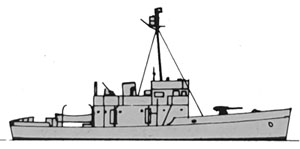
Specs:
Displacement: 232t trial
Dimensions: 120ft wl, 125ft oa x 23ft 4in x 7ft 36.58, 38.10 x 7.11 X 2.13m
Machinery: 2-shaft diesel, 600bhp 13.3kts
Armament: (1945) 1-3in 23 DP (none in Ewing Morris), 2-20mm, 2 DC racks, 2 Mousetrap
Complement: 38 (46 in 1945)
 Lake class Cutters (1927)
Lake class Cutters (1927)
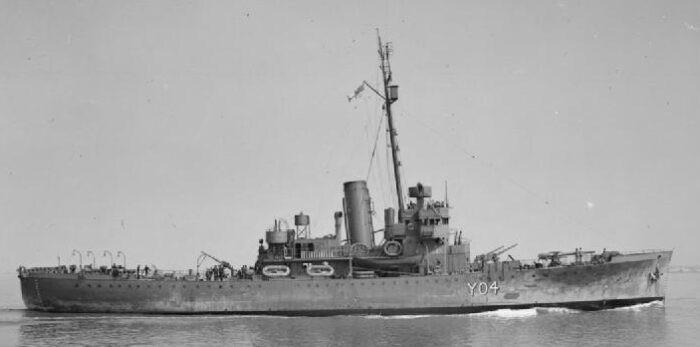
USCG Sebago (here in WW2 as HMS Walney)
Class:
Bethlehem, Quincy WPG45 WPG49, Chelan (to Britain 1941), Pontchartrain (to Britain 1941), Fahoe to Britain 1941), Champlain (to Britain 1941), Mendota (to Britain 1941).
General Engineering (WPGSO WPG53: Itasca (to Britain 1941), Sebago Co Britain 1941), Saranac (to Britain 1941), Shoshone (to Britain 1941).
United Divock (WPG54): Cayuga (to Britain 1941)
These ten turbo electric units were direct successors to four Tampa class cutters completed in 1921-22 with differences in electrical systems for the two groups of five. They introduced a new hull form. The Tampas had been designed in 1916 with the plumb bow and counter stern of previous ships, but ice patrol in the North Atlantic showed that the latter feature was undesirable: heavy seas coming up under the counter caused severe shocks. In this design, therefore, a slightly raking stem and a cruiser stern were adopted, together with some increase in power. All were transferred to the Royal Navy under Lend-Lease. These unusually powered ships were called the “turbo electric wonder boats”.
Specs:
Displacement 1662t trials 2075t full load
Dimensions: 239(wl)/250 ft oa x 42 x 12 fr 11 in (76.2 x 12.8 x 3.94m)
Powerplant: 1 shafts GE Turbines, 2 Babcock a Wilcox boilers 3350 hp 17 kts, oil 300t
Armament: 1x 5-in/51, 1x 3-in/50, 2x 6pdr.
Complement: 97
 USCG Northland (1927)
USCG Northland (1927)
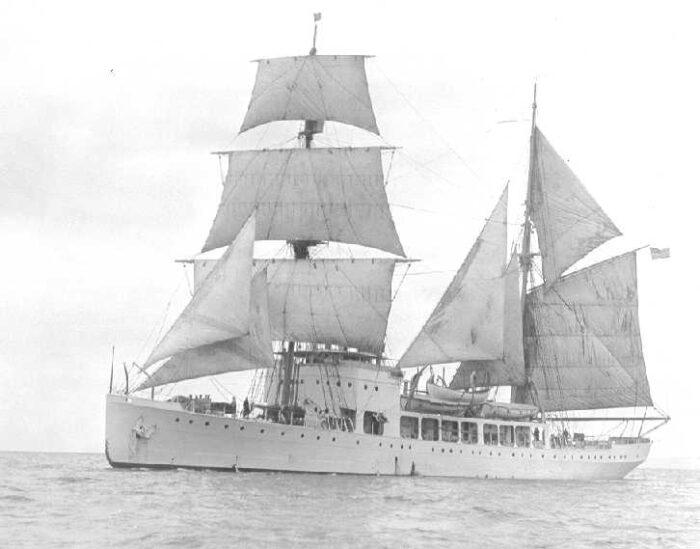
NORTHLAND was a Coast Guard cutter Launched on 5.2.1927. This ice-reinforced cutter (built by Newport News) was designed as a successor to the Bear, for Arctic service; she was an early example of largely welded hull construction, with diesel-electric propulsion. Bilge keels were not fitted in view of the likelihood of ice damage. Another unusual feature was the provision, at first, of sails as insurance against ice damage to the single propeller. The latter were removed in 1936. In wartime Northland (WPG49) was armed, carrying at the end of the war, two single 3in/50, 4-20mm, two depth charge racks and two K-guns, and was equipped with sonar as well as air and surface search radar.
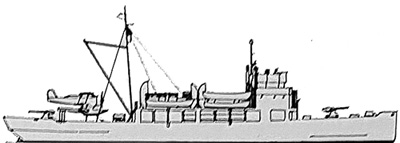
Specs:
Displacement: 1,785t trials
Dimensions: 200ft wl, 216ft 7in oa X 39ft x 13ft 8in trial 60.96, 66.02 x 11.89 x 4.17m.
Machinery: 1-shaft diesel, 1000bhp = 11.5kts
Armament: 2x 6-pdr, 1x 1-pdr, 1 aircraft
Complement: 107.
 Thetis (B) class Cutters (1931)
Thetis (B) class Cutters (1931)
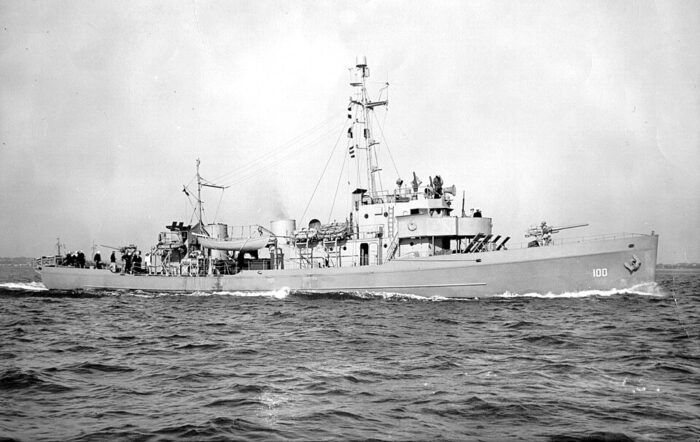
USCG THETIS (165ft ‘B’) class Coast Guard cutters (launched 1931-34)
Class:
Mathis WPC100, WPC108) ~ Arge (sold 1955), Galatea (to Dominican Republic 1948) (+ Lake Union WPCIOI, WPC102, WPCI05) — Anadne (decommissioned 23.12.68 , Atalanta (sold Dec 1954), Cyane (sold Dec 1954).
Bath Iron Wks WPC103, WPCLO4, WPC106, WPC1O9, WPCI1O, WPC114, WPCTIS) Atora decommissioned 17, 1.68), Calypso (ex-AG 15) (sold 1955), Daphne (sold 1988), Hermes (sold May 1958), Icarus (to Dominican Republic 5 1948), Persets sold 1962), Phaty (to Domimean Republic 1948).
Manitowoc (WPCIO7, W PCL13)Dione (discatded 1970s), 7 andora (discarded 1989).
Marietta WPCIHL, WPC112, WPC116)Nemegs (decommissioned 20.11.64), Nike discarded 1970s), Triton sold 16.1.69) .
Unlike the later ‘A’ type, these units were a direct consequence of Coast Guard experience during Prohibition, and indeed were intended to counter improvements in ‘rum-runner’ cargo ship effectiveness against trailing tactics by the earher 125ft class. They were ,thus, roughly comparable to the later Navy PCs and indeed may have inspired the original designation of the PC as a ‘165ft sub chaser’) whereas the ‘A’ class was more comparable to the 180ft PCE.
Of eighteen built, one Electra) was transferred to the Navy as the Presidential yacht Mavflower. Icarus, unassisted, actually sank a German submarine. The prewar battery of 1-3in 23 and 2~1pdr machine guns was increased, in wartime, to 2 3in 50, 2-20mm, 2 depth-charge racks, 2 K-guns and Mousetrap. The Coast Guard classed these units as WPCs and the ‘A’ class as WPGs, or gunboats.
Specs:
Displacement: 334t trials
Dimensions: 160ft 9in wl, 165ft oa x 23ft 9in x 7ft 8in trial 49,00, 50.29 x 7.24 x 2,34m
Machinery: 2-shaft diesel, 1,340bhp = 16kts
Armament: (1945) 2-3in/50, 2-20mm, 2 DC racks, 2 DC projectors, 2 Mousetrap
Complement: 50 (75 in 1945)
 Algonquin (A) class Cutters (1932)
Algonquin (A) class Cutters (1932)
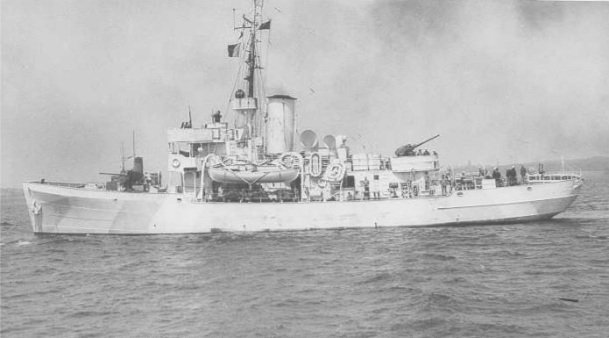
ALGONQUIN (165ft ‘A’) class Coast Guard cutters (launched 1932-34)
Class: Pusey & Jones (WPG75, WPG76, WPG78): Algonquin (BU 1948), Goma he (sold 1949), Mohawk (sold Nov 1948)
Defoe, Bay City (WPG77, WPG79, WPG80): Escanaba (lost 13.6.1943), Onondaga (sold Dec 1954), Tahoma (sold 1955).
Replacements for obsolete ‘tugboat’-type cutters developed from the Tallapoosa class launched in 1915, which was the first flush-decked type with good freeboard, the Algonguins were further intended to operate in severe ice conditions, with plating doubled around the bow, a cut-away forefoot, short length and medium draught. Wartime additions to armament were 2-20mm guns, 2 DC racks, 4 K-guns, and Mousetrap (all but Onondaga).
Specs:
Displacement: 1005t full load
Dimensions: 150ft wl, 165ft oa x 36ft x 12ft 3in full load 45.72, 50.29 X 10.97 x 3.73m
Machinery: l-shaft Westinghouse turbine, 2 Foster Wheeler boilers, 1500shp — 12.5kts. Oil 156t, range 3300nm at 10kts
Armament: 2-3in/50 Complement: 61 (98 in 1945)
 Treasury class Cutters (1936)
Treasury class Cutters (1936)
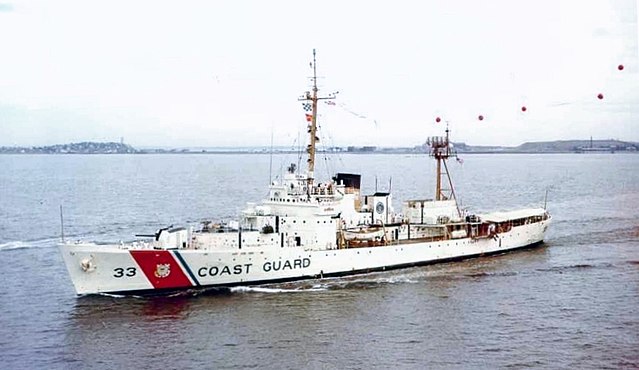
The TREASURY class Coast Guard cutters were launched 1936-37.
Class):
Charleston N Yd (WPG31): Bibb (in service 1980)
Philadelphia N Yd (WPG32, WPG33, WPG35, WPG37): Campbell (in service 1980), Duane (in service 1980), Ingham (in service 1980), Taney (in service 1980) New York N Yd (WPG34, WPG36) — Alexander Hamilton (sunk 30.1.42), Spencer (engineering training school 23.1.74)
These seven large cutters were perhaps the most successful built by the Coast Guard, at least up to the present series. Design requirements included a speed of 20kts and space on deck aft for both an aircraft and a large towing bitt well forward of rudders and propellers. The aircraft had to be carried in a hangar. Originally the Coast Guard planned to enlarge the very successful ‘Lake’ class, increasing beam to add deck area and increasing length ot 316ft for extra speed. The Coast Guard vessel was of conventional transverse-framed single-screw design; however, at the same time the Navy was designing the Ere class to a similar specification, with the new longitudinal framing and twin screws. Its design was adapted for Coast Guard use: the new 327ft cutter retained the hull framing, basic lines, and compartmentation of the gunboat, but used heavier scantlings and was altered in stem, stern, and skeg form to reflect Coast Guard requirements; in addition the superstructure was cut down to provide a long open quarterdeck.
The class was originally to have included ten ships; three were apparently switched to the later Owasco class when the latter was ordered in 1941. Originally, all seven vessels carried 2—Sin/51 forward, plus 2-6pdr and 1—lpdr. However, in 194] the aircraft was landed and replaced by a third Sin/51; in 1941, for example, Duane had 3-5in and 3 single 3in/50, as well as DC racks and K-guns; by that time these ships were being used as ASW escorts in the North Atlantic. Armament varied in wartime. For example, in 1942 Bibb showed 3in guns in ‘A’, ‘C’, ‘P’ and ‘X’ positions, and 5in/51 in ‘B’ and ‘Q’. Perhaps the most powerful battery carried was four 5in/38 in enclosed mounts (eg Taney, 1944).
Through 1944 their principal employment was as convoy flagships. However, that autumn all six surviving units were converted as amphibious flagships (AGC), with their superstructures built up amidships for additional accommodation; one or two additional pole masts were stepped. Batteries were sharply reduced. Duane was cut to 2 quadruple 40mm, 3 twin 40mm (one forward, two superfiring aft), and 8-20mm. Her sisters had two open merchant ship type Sin/38, as well as 3 twin 40mm and 4 or 8 ([ngham, Spencer) 20mm. So important was the AGC conversion that 1850-ton destroyers were withdrawn from Pacific service to replace the big ‘cutters’ as convoy flagships, and their reconstrucuon delayed accordingly. All six returned to their Coast Guard configurations post war.
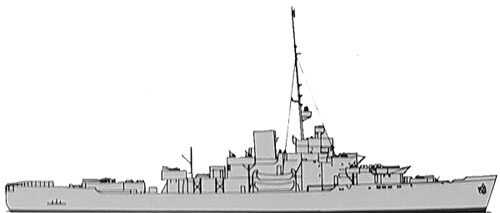
Specs:
Displacement: 2,350t trials
Dimensions: 308ft wl, 327ft oa x 41ft * 12ft 6in trial 93.88, 99.67 x 12.50 x 3.8m
Machinery: 2-shaft Westinghouse turbines, 2 Babcock & Wilcox boilers, 5n250shp = 19kts. Oil 561t, range 9500nm at 11kts
Armament: 2x 5-in/51, 2x 6pdr, 1x 1pdr, 1 aircraft
Complement: 123
 USCG Launches
USCG Launches
Under Prohibition, the Coast Guard built up a very large force of coastal craft, most notably the two hundred 203 74-ft 11-in motor Launches, which at that time represented the largest US postwar building programme. The Navy transferred nineteen World War I sub-chasers to the Coast Guard, and the Coast Guard also built a variety of speedboats and fast ‘picket boats’, Most of these craft had no ASW function, however, from 1941 onwards, the Coast Guard built 203 patrol boats, which did serve abroad; they were armed with 1x 20mm gun, 4 depth charge tracks, and Mousetrap, and thus were perhaps roughly equivalent to the British HDMLs. There were also nine 80-footer (1937) and six 78 footer (1929-31) motor launches, which were presumably design predecessors of the 83 footer type.
Originally all of these craft were numbered in a CG series; however, in wartime they were renumbered in a five-digit series of which the first (wo were the length: thus the 74ft 11in boats became 74300-74351; the 78 footer CG400—405 became 78300-78305; the 80 footer CG406—414 became 80300-80308; and the 83 footer CG450-489, 491-499 and 600-634 became 83300-83383, whereas later 83 ffoter boats became simply 83384-83529.
The USCG in WW2
1941 merge with the USN
During World War II, the United States Coast Guard (USCG) underwent a significant transformation, expanding its roles and responsibilities to support the Allied war effort across multiple theaters. At the onset of the war, the USCG operated under the Department of the Treasury. However, in 1941, it was transferred to the Department of the Navy, integrating more closely with military operations. The service expanded rapidly, growing from a modest force to over 170,000 personnel and operating a fleet that included 802 vessels of 65 feet or longer, along with nearly 8,000 smaller boats by 1943.
It was now tasked after december 1941 of Convoy Escort and Anti-Submarine Warfare: USCG cutters played a crucial role in protecting Allied convoys from German U-boats, conducting escort missions, depth charge attacks, and rescue operations in the Atlantic .
The USCG was responsible for the Greenland Patrol: The Coast Guard established the Greenland Patrol to support U.S. Army operations, defend against German activities, and build navigation and communication facilities in the region .
The USCG contributed to Amphibious Operations: Coast Guardsmen were integral to amphibious landings in North Africa, Sicily, Italy, and France, manning various support vessels and participating directly in combat operations. Rescue Flotilla One: On D-Day, a fleet of 60 wooden 83-foot cutters, known as Rescue Flotilla One, saved nearly 500 men from the waters off Normandy beaches, showcasing the USCG’s commitment to lifesaving missions.
First Engagement: The cutter Northland made the first U.S. naval capture of the war, seizing a German trawler off Greenland before the official U.S. entry into the conflict.
Medal of Honor: Signalman First Class Douglas A. Munro became the only Coast Guardsman to receive the Medal of Honor for his heroic actions during the evacuation of Marines at Guadalcanal.
Technological Advancements: The USCG collaborated in developing the Long Range Navigation (LORAN) system, a precursor to modern GPS, enhancing navigation capabilities for Allied forces.
USCG Assets: Interwar and WW2
 Owasco class USCG Cutters (1944)
Owasco class USCG Cutters (1944)
To be expanded 2026
 Wind class USCG Cutters (1942)
Wind class USCG Cutters (1942)
To be expanded 2026
 Coast Guard Launches
Coast Guard Launches
To be expanded 2026
The USCG in the cold war
During the Cold War, the United States Coast Guard (USCG) expanded its traditional roles to address emerging geopolitical challenges, integrating into national defense and intelligence operations while maintaining its humanitarian and law enforcement missions.
The USCG played a pivotal role in intelligence gathering during the Cold War. Notably, it conducted reconnaissance flights off Cape Canaveral, Florida, during the 1960s and 1970s to monitor foreign vessels, often disguised as fishing trawlers, that appeared during U.S. rocket launch preparations. These missions aimed to identify and assess potential intelligence threats near critical aerospace facilities.
Additionally, the USCG’s Pacific Area Intelligence Division (PACAREA) was instrumental in maritime surveillance and intelligence operations, contributing to national security efforts throughout the Cold War era.
Psychological Operations:
The Cutter Courier: In 1952, the USCG commissioned the Cutter Courier, a unique vessel equipped with powerful radio transmitters to broadcast Voice of America (VOA) programming. Stationed off Rhodes, Greece, the Courier transmitted messages aimed at countering Soviet propaganda and promoting democratic ideals to Eastern Bloc countries. This operation exemplified the USCG’s involvement in psychological warfare and information dissemination during the Cold War.
Arctic and Icebreaking Missions:
The USCG maintained a significant presence in polar regions, conducting icebreaking operations essential for national defense and scientific research. Its icebreakers supported supply missions to Arctic installations and facilitated the construction of the Alaska Pipeline in the 1970s. These operations underscored the strategic importance of the Arctic during the Cold War.
Law Enforcement and Maritime Security:
Throughout the Cold War, the USCG continued its law enforcement duties, including port security, maritime law enforcement, and search and rescue operations. It adapted to emerging threats such as drug trafficking and illegal immigration, enhancing its capabilities to address these challenges effectively.
Intelligence Contributions:
The USCG’s intelligence efforts extended beyond reconnaissance flights. Its intelligence division contributed to broader national security objectives, including monitoring maritime activities and supporting anti-submarine warfare initiatives. These contributions were integral to the United States’ overall intelligence apparatus during the Cold War.
Cold War Assets
 Hamilton class Coast Guard Cutters (1965)
Hamilton class Coast Guard Cutters (1965)
To be expanded 2027
 Reliance class Coast Guard Cutters (1966)
Reliance class Coast Guard Cutters (1966)
To be expanded 2027
 Bear class Coast Guard Cutters (1980)
Bear class Coast Guard Cutters (1980)
To be expanded 2027
 Coast Guard Patrol Boats
Coast Guard Patrol Boats
To be expanded 2027
 Former Navy Units
Former Navy Units
To be expanded 2027
The USCG Today: Organization and assets.
The United States Coast Guard (USCG) is a unique branch of the U.S. Armed Forces, operating under the Department of Homeland Security during peacetime and transferring to the Department of the Navy during wartime. Established in 1790 by Secretary of the Treasury Alexander Hamilton as the Revenue Marine Service, it is the nation’s oldest continuous seagoing service.
The Coast Guard fulfills a broad range of responsibilities, organized into three primary roles:
Maritime Safety: Conducting search and rescue operations, enforcing vessel safety regulations, and maintaining aids to navigation.
Maritime Security: Executing drug and migrant interdiction, ensuring port and waterway security, and maintaining defense readiness.
Maritime Stewardship: Protecting marine environments, enforcing fisheries laws, and conducting icebreaking operations.
These roles encompass eleven statutory missions, including ice operations, marine environmental protection, and maritime law enforcement.
Personnel and Assets:
The USCG comprises approximately 44,500 active-duty members, 7,000 reservists, 8,577 civilian employees, and 21,000 volunteers in the Coast Guard Auxiliary. Its fleet includes around 250 cutters, nearly 2,000 small boats, and over 200 aircraft.
Strategic Importance:
Beyond domestic operations, the Coast Guard plays a vital role in international maritime security, environmental protection, and humanitarian missions. Its presence in the Arctic is increasingly significant due to climate change and geopolitical interests, as highlighted by recent deployments and research missions.
Today’s USCG Assets
The Coast Guard operates 243 “cutters” (above 65 feet ot 20 m long).
 National Security Cutter (WMSL)
National Security Cutter (WMSL)
Legend-class: Latest 418-foot (127 m) cutters, largest in active service. Replaced individually the decommissioned 1960s Hamilton-class cutters, (High Endurance Cutter or WHEC) for a total of 11 authorized and budgeted, 8 by 2021, 2 TBC 2023-25.
 Medium Endurance Cutter (WMEC)
Medium Endurance Cutter (WMEC)
-210-foot (64 m) Reliance-class
-270-foot (82 m) Famous-class.
-283-foot (86 m) Alex Haley.
Primary missions: law enforcement, search and rescue, and military defense.
The Heritage-class cutters are planned to replace the Reliance and Famous-class cutters.
Polar-class icebreaker (WAGB): Three WAGB’s used for icebreaking and research though only two, the heavy 399-foot (122 m) Polar Star and the newer medium class 420-foot (130 m) Healy, are active.] Polar Sea is located in Seattle, Washington but is not currently in active service. The icebreakers are being replaced with new heavy icebreakers under the Polar icebreaker program, the world’s largest coast guard vessel due for delivery in 2025.
USCGC Storis: A 360-foot (110 m) Icebreaker previously used by Royal Dutch Shell before being bought by the Coast Guard in December 2024.
USCGC Eagle: A 295-foot (90 m) sailing barque used as a training ship for Coast Guard Academy cadets and Coast Guard officer candidates. She was originally built in Germany as Horst Wessel, and was seized by the United States as a prize of war in 1945.[101][102]
USCGC Mackinaw: A 240-foot (73 m) heavy icebreaker built for operations on the Great Lakes.
 USCG Auxiliaries
USCG Auxiliaries
Seagoing Buoy Tender (WLB): These 225-foot (69 m) ships are used to maintain aids to navigation and also assist with law enforcement and search and rescue.
Coastal Buoy Tender (WLM): The 175-foot (53 m) Keeper-class coastal buoy tenders are used to maintain coastal aids to navigation.
Sentinel-class cutter (WPC): The 154-foot (47 m) Sentinel-class, also known by its program name, the “Fast Response Cutter”-class and is used for search and rescue work and law enforcement.
Bay-class icebreaking tug (WTGB): 140-foot (43 m) icebreakers used primarily for domestic icebreaking missions. Other missions include search and rescue, law enforcement, and aids to navigation maintenance.[103]
Patrol Boats (WPB): There are two classes of WPBs currently in service; the 110-foot (34 m) Island-class patrol boats and the 87-foot (27 m) Marine Protector-class patrol boats[104][105]
Small Harbor Tug (WYTL): 65-foot (20 m) small icebreaking tugboats, used primary for ice clearing in domestic harbors in addition to limited search and rescue and law enforcement roles.
 USCG boats
USCG boats
The Coast Guard operates about 1,650 boats,[20] defined as any vessel less than 65 feet (20 m) long, which generally operate near shore and on inland waterways.
-47-foot Motor Lifeboat (MLB): The Coast Guard’s 47-foot (14 m) primary heavy-weather boat used for search and rescue as well as law enforcement and homeland security.
-Response Boat – Medium (RB-M): A new multi-mission 45-foot (14 m) vessel intended to replace the 41-foot (12 m) utility boat. 170 planned
-Deployable Pursuit Boat (DPB): A 38-foot (12 m) launch capable of pursuing fast cocaine smuggling craft.
-Long Range Interceptor (LRI): A 36-foot (11 m) high-speed launch that can be launched from the stern ramps of the larger Deepwater cutters.
-Aids to Navigation Boat (TANB/BUSL/ATON/ANB): Various designs ranging from 26 to 55 feet (7.9 to 16.8 m) used to maintain aids to navigation.
– Special Purpose Craft – Law Enforcement (SPC-LE): Intended to operate in support of specialized law enforcement missions, utilizing three 300 horsepower (220 kW) Mercury Marine engines. The SPC-LE is 33 feet (10 m) long and capable of speeds in excess of 50 knots (93 km/h; 58 mph) and operations more than 30 miles (48 km) from shore.
-29-foot Response Boat Small II (RBS-II): The successor to the 25-foot RB-S, the RBS-II is a 29 foot (9 m) high speed, multi-mission boat commonly used for search and rescue, port security, and law enforcement. Improvements from the RB-S include improved visibility and modernized electronic chart plotter capabilities.
-25-foot Transportable Port Security Boat (TPSB): A 25-foot (7.6 m) well-armed boat used by Port Security Units for force protection.
-Special Purpose Craft, Shallow-water (SPC-SW): 24 feet (7.3 m)[clarification needed]
-Cutter Boat – Over the Horizon (OTH): A 23-foot (7.0 m) rigid hull inflatable boat used by medium and high endurance cutters and specialized units.
-Short Range Prosecutor (SRP): A 23-foot (7.0 m) rigid hull inflatable boat that can be launched from a stern launching ramp on the National Security Cutters.
(To be expanded in 2026)
Read More/Src
Books
Links
https://www.uscg.mil/
https://en.wikipedia.org/wiki/United_States_Coast_Guard
https://www.usni.org/magazines/proceedings/1959/june/story-coast-guard-aviation
https://en.wikipedia.org/wiki/History_of_the_United_States_Coast_Guard
USCG Historian’s Office Cold War Collection
https://web.archive.org/web/20190711041447/http://www.usspotomac.org/education/documents/sister_ships_coast_guard_patrol_boats.pdf
https://www.ibiblio.org/hyperwar/USN/ships/ships-cg.html
https://laststandonzombieisland.com/tag/lake-class-cutters/
https://uboat.net/allies/warships/class.html?ID=586&navy=USCGC
https://www.naval-history.net/OW-US/Atalanta/USCGC_Atalanta.htm



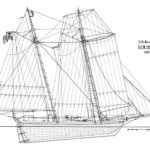
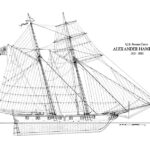
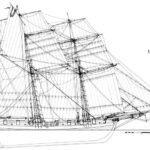
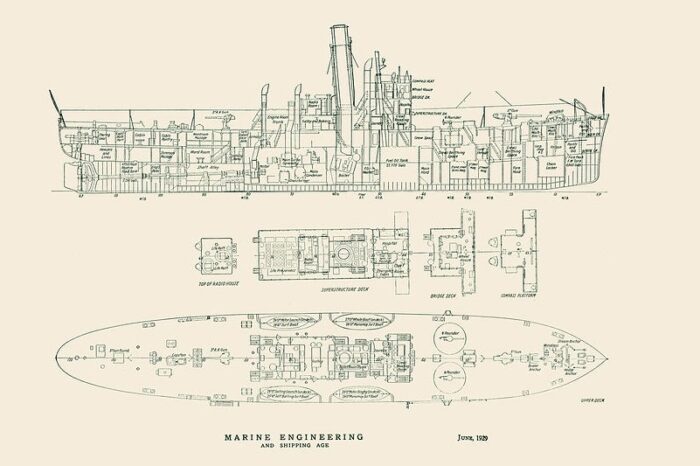
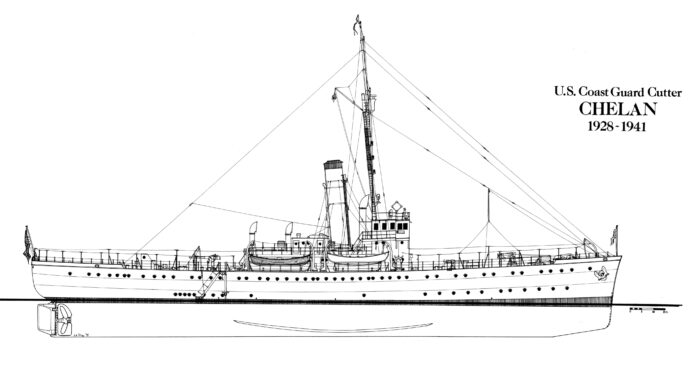
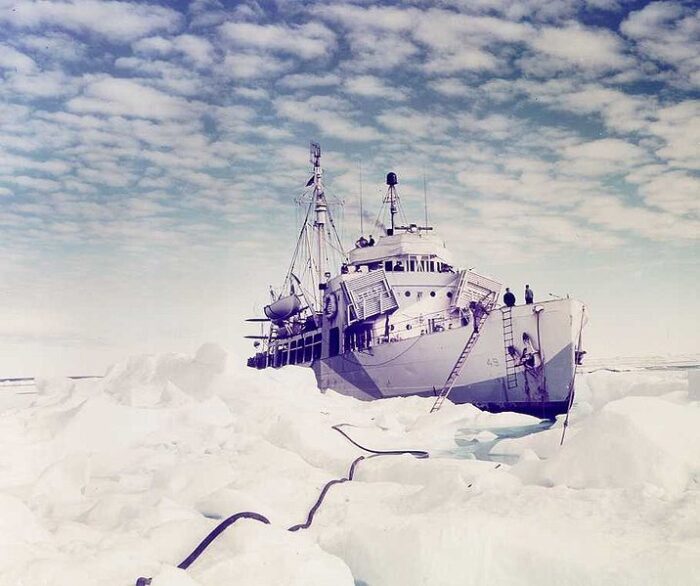
 Latest Facebook Entry -
Latest Facebook Entry -  X(Tweeter) Naval Encyclopedia's deck archive
X(Tweeter) Naval Encyclopedia's deck archive Instagram (@navalencyc)
Instagram (@navalencyc)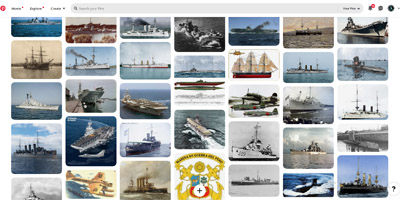

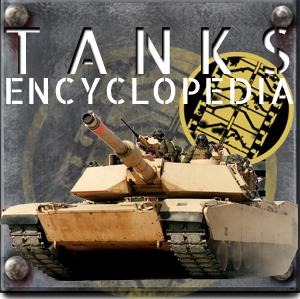
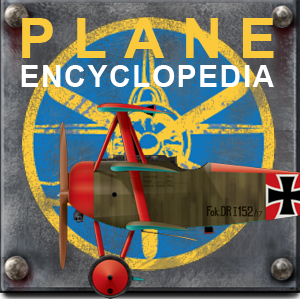
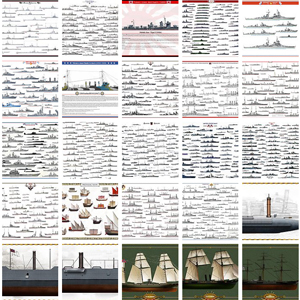
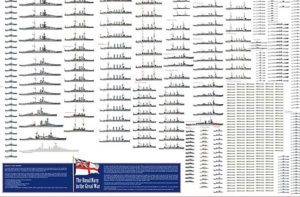
 French Navy
French Navy Royal Navy
Royal Navy Russian Navy
Russian Navy Armada Espanola
Armada Espanola Austrian Navy
Austrian Navy K.u.K. Kriegsmarine
K.u.K. Kriegsmarine Dansk Marine
Dansk Marine Nautiko Hellenon
Nautiko Hellenon Koninklije Marine 1870
Koninklije Marine 1870 Marinha do Brasil
Marinha do Brasil Osmanlı Donanması
Osmanlı Donanması Marina Do Peru
Marina Do Peru Marinha do Portugal
Marinha do Portugal Regia Marina 1870
Regia Marina 1870 Nihhon Kaigun 1870
Nihhon Kaigun 1870 Preußische Marine 1870
Preußische Marine 1870 Russkiy Flot 1870
Russkiy Flot 1870 Svenska marinen
Svenska marinen Søværnet
Søværnet Union Navy
Union Navy Confederate Navy
Confederate Navy Armada de Argentina
Armada de Argentina Imperial Chinese Navy
Imperial Chinese Navy Marinha do Portugal
Marinha do Portugal Mexico
Mexico Kaiserliche Marine
Kaiserliche Marine 1898 US Navy
1898 US Navy Sovietskiy Flot
Sovietskiy Flot Royal Canadian Navy
Royal Canadian Navy Royal Australian Navy
Royal Australian Navy RNZN Fleet
RNZN Fleet Chinese Navy 1937
Chinese Navy 1937 Kriegsmarine
Kriegsmarine Chilean Navy
Chilean Navy Danish Navy
Danish Navy Finnish Navy
Finnish Navy Hellenic Navy
Hellenic Navy Polish Navy
Polish Navy Romanian Navy
Romanian Navy Turkish Navy
Turkish Navy Royal Yugoslav Navy
Royal Yugoslav Navy Royal Thai Navy
Royal Thai Navy Minor Navies
Minor Navies Albania
Albania Austria
Austria Belgium
Belgium Columbia
Columbia Costa Rica
Costa Rica Cuba
Cuba Czechoslovakia
Czechoslovakia Dominican Republic
Dominican Republic Haiti
Haiti Hungary
Hungary Honduras
Honduras Estonia
Estonia Iceland
Iceland Eire
Eire Equador
Equador Iran
Iran Iraq
Iraq Latvia
Latvia Liberia
Liberia Lithuania
Lithuania Mandchukuo
Mandchukuo Morocco
Morocco Nicaragua
Nicaragua Persia
Persia San Salvador
San Salvador Sarawak
Sarawak Uruguay
Uruguay Venezuela
Venezuela Zanzibar
Zanzibar Warsaw Pact Navies
Warsaw Pact Navies Bulgaria
Bulgaria Hungary
Hungary

 Bundesmarine
Bundesmarine Dutch Navy
Dutch Navy Hellenic Navy
Hellenic Navy Marina Militare
Marina Militare Yugoslav Navy
Yugoslav Navy Chinese Navy
Chinese Navy Indian Navy
Indian Navy Indonesian Navy
Indonesian Navy JMSDF
JMSDF North Korean Navy
North Korean Navy Pakistani Navy
Pakistani Navy Philippines Navy
Philippines Navy ROKN
ROKN Rep. of Singapore Navy
Rep. of Singapore Navy Taiwanese Navy
Taiwanese Navy IDF Navy
IDF Navy Saudi Navy
Saudi Navy Royal New Zealand Navy
Royal New Zealand Navy Egyptian Navy
Egyptian Navy South African Navy
South African Navy






























 Ukrainian Navy
Ukrainian Navy dbodesign
dbodesign